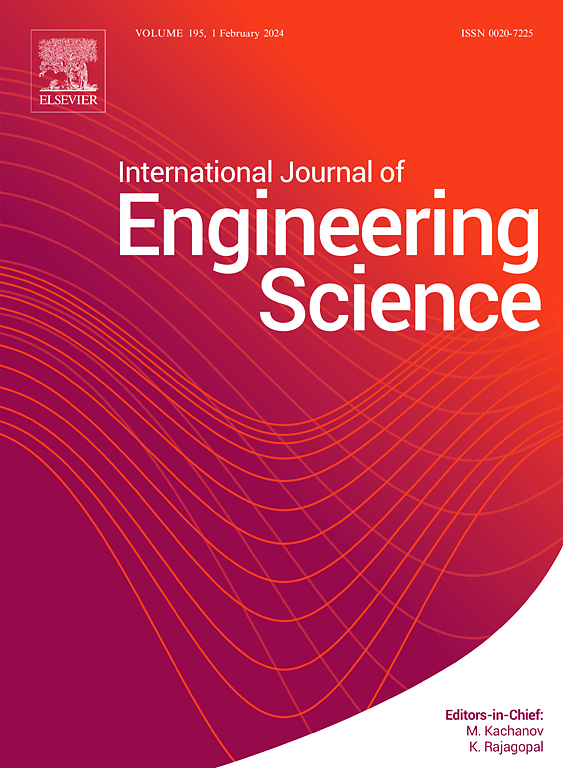基于势场分析的状态周动力介质的动力行为
IF 5.7
1区 工程技术
Q1 ENGINEERING, MULTIDISCIPLINARY
International Journal of Engineering Science
Pub Date : 2025-04-09
DOI:10.1016/j.ijengsci.2025.104261
引用次数: 0
摘要
与依赖局部相互作用和微分方程的经典理论不同,周动力学理论使用积分微分方程来描述材料和结构的力学。这种独特的方法使周动力学能够自然地纳入远程力和不连续,例如裂缝,这是使用经典偏微分方程难以处理的。本文提出了一种实现非局部Helmholtz-Hodge分解的新方法,将位移场分解为无散度和无旋度的分量。本文考虑了基于状态的周动力学,它是为了克服基于键的周动力学的局限性而引入的。因此,导出了两个涉及积分的控制方程,这两个方程与势场有关。对波的传播进行了分析,以确定纵波和横波的色散关系。导出了初值问题的一般解,并得到了格林函数在势场中的封闭表达式。本研究考虑高斯函数、指数函数和常数函数作为非定域函数。图显示了频率、相速度随视界大小(表示非局域长度)和非局域函数变化的变化。通过保证非局域参数极限趋近于零时的经典对应性,从解析和数值两方面进行了验证。这项工作实现了非局部亥姆霍兹分解,这是一个强大的框架,简化了研究,并在分析向量场时提供了全面的见解。本文章由计算机程序翻译,如有差异,请以英文原文为准。
Dynamic behaviour of state-based peridynamic media through analysis of potential fields
Unlike classical theories, which rely on local interactions and differential equations, peridynamic theory employs integro-differential equations to describe the mechanics of materials and structures. This distinctive approach allows peridynamics to naturally incorporate long-range forces and discontinuities, such as cracks, which are challenging to handle using classical partial differential equations. In this study, a novel approach for the implementation of nonlocal Helmholtz-Hodge decomposition is used to decompose the displacement field into components that are divergence-free and curl-free. State-based peridynamics, which was introduced to overcome the limitations of bond-based peridynamics, has been considered in this work. As a consequence, two governing equations involving integrals are derived, which are associated with potential fields. An analysis of the propagation of waves has been performed to determine the dispersion relation for both longitudinal and transverse waves. The general solutions for initial-value problems are derived, and the closed-form expression for Green’s function in terms of potential fields is obtained. This study considers Gaussian, exponential, and constant functions as nonlocality functions. Graphs are demonstrated to illustrate the variations in frequency, phase velocity with changes in the size of the horizon (which represents nonlocal length) and nonlocality functions. The validation is achieved both analytically and numerically by ensuring classical correspondence in the limit of the nonlocality parameters approach zero. This work implements nonlocal Helmholtz decomposition, a robust framework that simplifies the study and provides comprehensive insight while analysing vector fields.
求助全文
通过发布文献求助,成功后即可免费获取论文全文。
去求助
来源期刊

International Journal of Engineering Science
工程技术-工程:综合
CiteScore
11.80
自引率
16.70%
发文量
86
审稿时长
45 days
期刊介绍:
The International Journal of Engineering Science is not limited to a specific aspect of science and engineering but is instead devoted to a wide range of subfields in the engineering sciences. While it encourages a broad spectrum of contribution in the engineering sciences, its core interest lies in issues concerning material modeling and response. Articles of interdisciplinary nature are particularly welcome.
The primary goal of the new editors is to maintain high quality of publications. There will be a commitment to expediting the time taken for the publication of the papers. The articles that are sent for reviews will have names of the authors deleted with a view towards enhancing the objectivity and fairness of the review process.
Articles that are devoted to the purely mathematical aspects without a discussion of the physical implications of the results or the consideration of specific examples are discouraged. Articles concerning material science should not be limited merely to a description and recording of observations but should contain theoretical or quantitative discussion of the results.
 求助内容:
求助内容: 应助结果提醒方式:
应助结果提醒方式:


